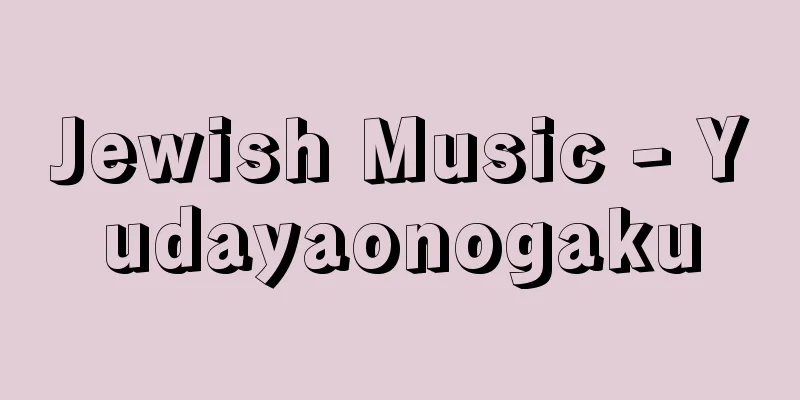Jewish Music - Yudayaonogaku

|
Music of the Jewish people. Because it has been passed down mainly orally throughout its long historical transition and geographical spread, its music has a wide variety of aspects. [Ryuichi Tai] Ancient HebrewAccording to the descriptions in the Old Testament, various kinds of music were performed, including music and dances that accompanied worship and prayer, and music for victory in battle. Instruments mentioned include small cymbals, frame drums, lyres, reed flutes, silver trumpets, and the horn (shofar). Of these, the shofar is still used in Jewish rituals today. Furthermore, during the time of David and Solomon (the monarchy period after the 10th century BC), grand worship music was performed in the temple in connection with the offering of sacrifices. [Ryuichi Tai] Discrete PeriodAfter the destruction of the Second Temple in Jerusalem in 70 AD, the Jewish people were dispersed all over the world, but three groups were formed later. The first group was the Oriental group, living in Yemen, Iraq, Iran, etc., and is said to have preserved the oldest Jewish musical traditions. The second group was the Sephardim, Jews of Spanish and Portuguese descent, who developed a rich musical culture influenced by Spanish and Arabic music. They also produced folk songs in Ladino, a mixture of Hebrew and Spanish (such as "Les le monsieurs de France"). The third group was the Ashkenazim, Jews of German, Polish, and Russian descent, whose music is highly expressive and technical. Later, they also produced folk songs in Yiddish, a mixture of Hebrew and German (such as "Dona Dona"). Generally speaking, Jewish music during the Diaspora had a tendency to inherit old traditions while also incorporating and fusing with the music of the various ethnic groups around the area where they lived. Also during the Diaspora, liturgical music in Jewish churches (synagogues) was systematized, and singing methods such as reciting the Old Testament, chanting psalms, prayer songs, and hymns were established. Furthermore, in the 18th century, Hasidism, a form of Jewish mysticism, arose among the Ashkenazim, and produced extremely vibrant hymns, which eventually developed into the wordless song Nigun, which was sung using vowel singing. [Ryuichi Tai] Modern JudaismThe Jews who began to immigrate to Palestine under the Zionist movement at the end of the 19th century brought with them the rich musical culture that had developed in their homelands. Since the establishment of the State of Israel in 1948, many modern Hebrew folk songs (such as "Mayim Mayim") have been created. Furthermore, Jewish immigration to America peaked in the 20th century, and Jewish American musicians, especially in pop music, have come to have a widespread influence on the music world not only in America but also around the world. One example is the musical "Fiddler on the Roof" (lyrics by Sheldon Harnick, music by Jerry Bock, premiered in 1964), which was originally a work for the Yiddish theater. [Ryuichi Tai] "History of Jewish Folk Music" by Nobuo Mizuno (1980, Rokuko Publishing) " "Jewish Hymns" by Nobuo Mizuno (1986, Jerusalem Institute of Religious Culture) Source: Shogakukan Encyclopedia Nipponica About Encyclopedia Nipponica Information | Legend |
|
ユダヤ民族の音楽。その長い歴史的変遷と民族の地理的拡散のなかに主として口伝によって伝承されてきたため、その音楽には多様な様相がみられる。 [田井竜一] 古代ヘブライ期『旧約聖書』の記述によると、礼拝や祈祷(きとう)に伴う音楽と舞踊、戦いの勝利の音楽などさまざまな音楽が演奏されていたことがうかがえる。楽器では小形シンバル、枠太鼓、リラの類、リード笛、銀製トランペット、角笛(つのぶえ)(ショファール)などの名があげられる。このうち、ショファールは今日のユダヤ教儀式でも使用されている。さらにダビデ・ソロモン時代(前10世紀以後の王政時代)には、神殿において犠牲の奉献と結び付いた盛大な礼拝音楽が演じられた。 [田井竜一] 離散期紀元70年のエルサレム第二神殿崩壊後、ユダヤ民族は全世界に離散してゆくが、のちに三つのグループが形成されるようになった。その第一はイエメン、イラク、イランなどに居住するオリエント系で、もっとも古いユダヤ音楽の伝統を保っているといわれている。第二はセファルディムとよばれるスペイン・ポルトガル系ユダヤ人で、スペインとアラビア音楽の影響を受けて豊かな音楽文化を発展させた。またヘブライ語とスペイン語との混合言語であるラディーノ語による民謡(『フランスの王様』など)も生まれた。第三はアシュケナジムとよばれるドイツ・ポーランド・ロシア系ユダヤ人で、その音楽はきわめて表現・技巧的な性格をもっている。のちにヘブライ語とドイツ語の混合言語であるイディッシュ語による民謡(『ドナ・ドナ』など)も形成された。 一般に離散期のユダヤ音楽には、古い伝統を受け継ぐ一方、居住地周辺の諸民族の音楽を取り入れそれと融合してゆく傾向がある。また離散期にはユダヤ教会(シナゴーグ)における典礼音楽も体系化され、『旧約聖書』の朗誦(ろうしょう)、詩篇(しへん)唱、祈祷歌、讃歌(さんか)などの唱法が整った。さらに18世紀にはアシュケナジムのなかでユダヤ教神秘主義ハシディズムがおこり、きわめてバイタリティーに富んだ讃歌を生み出したが、やがてそれは母音唱法によることばのない歌ニーグンに発展していく。 [田井竜一] 現代ユダヤ19世紀末以降シオニズム運動のもとでパレスチナに移住を開始したユダヤ人は、出身地ではぐくんできた豊かな音楽文化を持ち寄った。また1948年のイスラエル建国以後は、現代ヘブライ語によるフォーク・ソング(『マイムマイム』など)も多数生まれている。さらにユダヤ人のアメリカへの移住は20世紀に入って頂点に達したが、やがてポピュラー音楽を中心に、ユダヤ系アメリカ人の音楽家がアメリカのみならず世界の音楽界に広く影響を与えるに至った。その一例として、本来はイディッシュ劇場のための作品であったミュージカル『屋根の上のバイオリン弾き』(シェルドン・ハーニック作詞、ジェリー・ボック作曲、1964初演)をあげることができる。 [田井竜一] 『水野信男著『ユダヤ民族音楽史』(1980・六興出版)』▽『水野信男著『ユダヤ教の聖歌』(1986・エルサレム宗教文化研究所)』 出典 小学館 日本大百科全書(ニッポニカ)日本大百科全書(ニッポニカ)について 情報 | 凡例 |
Recommend
frigorífico (English spelling) [Spain]
In South America, this term refers to a "free...
Kalanchoe beharensis (English spelling)
… [Hiroshi Yuasa]. … *Some of the terminology tha...
Inlay (English spelling)
One method of treating cavities is to grind down t...
Titus Flavius Vespasianus
Roman Emperor (reigned 79-81). He was the eldest ...
Olympic Games
…Abbreviation for the Olympic Games. In Japan, it...
Hamamelis mollis (English spelling)
… [Toshio Hamatani]. … *Some of the terminology t...
Hell Story - Jigokuzoushi
This is a picture scroll depicting the state of h...
Kshatriya - Katriya (English spelling)
One of the four social classes (varna) that exist...
Queen's Courts
… [Outline of national politics] (1) The King and...
Guttmann, L.
...The reason why physical activity, which was of...
major
An international oil cartel. Formally, it was a 19...
Functional Layer - Yesterday
…Then, when the corpus luteum is formed, it begin...
Montagu, ES (English spelling) MontaguES
…This report, submitted to the British Parliament...
Akira Ifukube
Composer. Born in Kushiro-cho, Hokkaido (now Kush...
Iwagasaki
A district of Kurihara City in northern Miyagi Pr...









